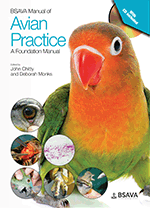
Full text loading...

The diagnosis and treatment of musculoskeletal injuries in birds share similar diagnostic modalities, principles of wound healing and methods of fracture stabilization with the approaches used in mammalian medicine. It is important to remember these fundamental principles when approaching such injuries in birds. This chapter covers initial assessment, diagnosis of musculoskeletal injury to the limbs, treatment principles and techniques, postoperative care and rehabilitation of both wing and leg trauma. Case examples: Harrier Hawk with fractured wing; Brown Kiwi with fractured tibiotarsus; New Zealand Wood Pigeon with a fractured coracoid and clavicle. The chapter also includes two video clips.
Wing and leg trauma, Page 1 of 1
< Previous page | Next page > /docserver/preview/fulltext/10.22233/9781910443323/9781910443323.29-1.gif

Full text loading...











Supplements
Spring test on the right wing of a Barbary Falcon. The bird has a fracture of the right coracoid. The spring test of the distal wing is normal, while the test of the proximal joint shows a failure to return to normal resting position. Normally this would be performed on a conscious bird, however for welfare reasons this video was taken of an anaesthetised bird
Spring test on the left wing of a Barbary Falcon. The bird has a fracture of the right coracoid. The spring tests of both proximal and distal parts of the wing are normal with the wing returning to normal resting position after the wing is extended and released. Normally this would be performed on a conscious bird, however for welfare reasons this video was taken of an anaesthetised bird